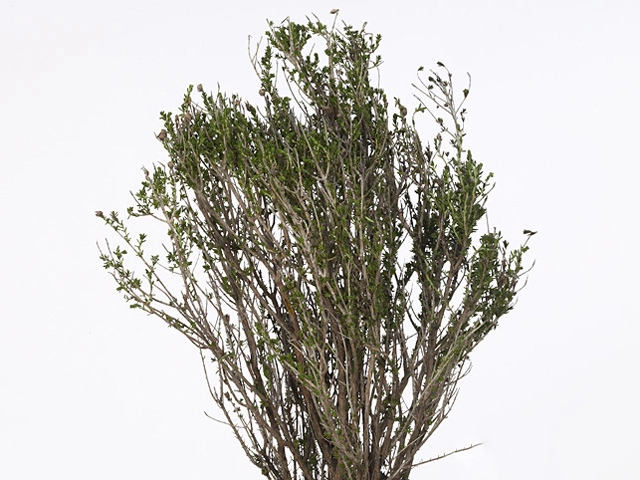Thymus capitatus per bunch

| Leaf, general shape | Needle-shaped |
| Leaf, scent | Pleasantly scented |
| Leaf width | 0 - 1 cm; Very small |
| Leaf size | 0 - 1 cm |
| Leaf, main color | Medium green |
| Leaf colour, pattern | Unicolored |
Thyme, scientifically known as Thymus capitatus, is a herb that is treasured for its aromatic leaves and various culinary uses. The thyme plant typically produces tiny needle-shaped leaves that are pleasantly scented, adding a delightful aroma to any dish.
When it comes to the appearance of thyme leaves, they are very small, measuring between 0 and 1 centimeter in width and length. Despite their diminutive size, these leaves pack a punch of flavor, making them a versatile herb that is loved by chefs and home cooks alike.
The color of thyme leaves is a vibrant medium green, giving them a fresh and lively appearance. These leaves have a unicolored pattern, meaning they do not display any intricate designs or variations in color. Instead, the rich shade of green remains consistent throughout the entire leaf surface.
Thyme is a popular herb that is used in various cuisines around the world. Its pleasant scent and distinct flavor make it a staple in Mediterranean and Middle Eastern cooking. It pairs well with a wide range of dishes, including roasted meats, vegetables, soups, and stews.
Apart from its culinary uses, thyme also boasts several health benefits. It contains essential oils and compounds with antibacterial and antioxidant properties. Thyme has been used for centuries in traditional medicine to alleviate coughs, congestion, and sore throats. It is also believed to have anti-inflammatory properties and may help boost the immune system.
Growing thyme is relatively easy, making it a favorite herb for gardeners. It thrives in well-draining soil with plenty of sunlight. Thyme plants can be grown in containers or in a garden bed, adding beauty and functionality to any outdoor space.
In conclusion, Thymus capitatus, or thyme, is a herb loved for its needle-shaped leaves, pleasant scent, and small size. With its vibrant medium green color and unicolored pattern, thyme brings visual appeal to culinary dishes. Whether used in cooking or for its medicinal properties, thyme is a versatile herb that has stood the test of time. So, next time you need to add a burst of flavor and aroma to your dish, reach for some fresh thyme leaves and let your culinary creativity soar.
Market availability index by month:
| Jan. | Feb. | Mar. | Apr. | May | Jun. | Jul. | Aug. | Sep. | Oct. | Nov. | Dec. |
|---|---|---|---|---|---|---|---|---|---|---|---|
| 4 | 4 | 3 | 3 | 4 | 3 | 3 | 3 | 3 | 3 | 3 | 3 |